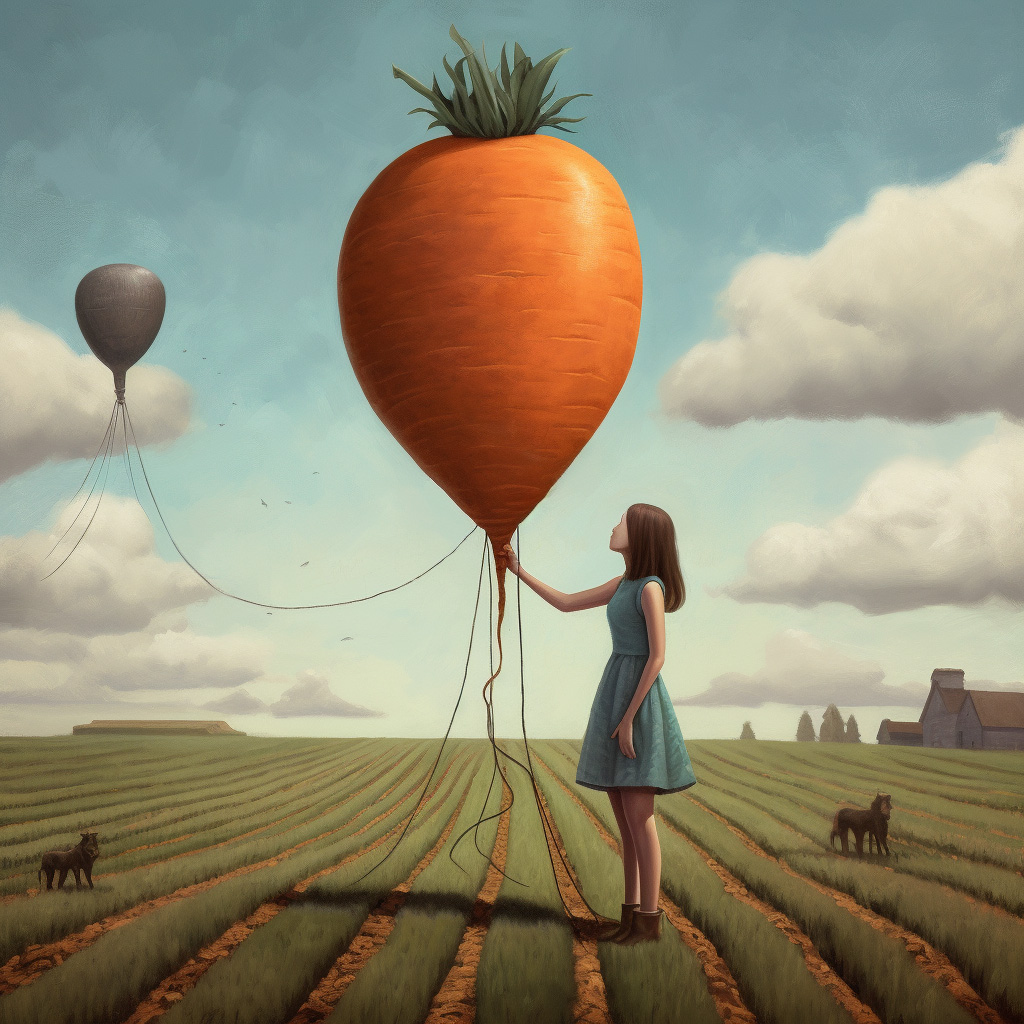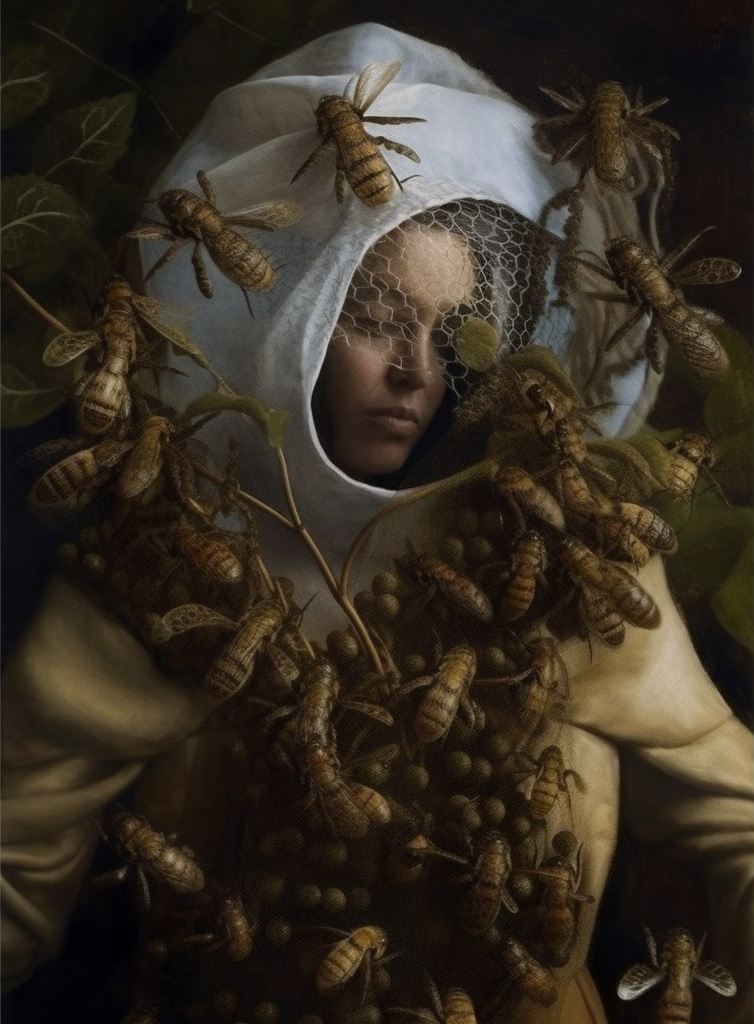Yesterday,
Today,
Tomorrow
how will the emergence of ai affect the art and design industries?
how will the emergence of ai
affect the art and design industries?
By Charles Hively | Illustrations by Q. Cassetti
Artists have been making marks on surfaces for centuries—32,000 years ago on walls in caves, later on panels and wet lime plaster, and later still on canvas—and today we’re programmed from an early age to use a computer to create and view art.
During my time as an art director and illustrator, there were innumerable advances. Where once we hand-lettered headlines and subheads, that task was replaced by dry-transfer Letraset. Instead of pastels, we turned to Magic Markers to create color roughs. For images, we had stock photo sources or catalogs we could Xerox. Still everything was hand-done, whether it was using a temperamental Radiograph pen or cutting Rubylith patterns for full-color separations. Once a project was approved, we relied on outside resources for typesetting, retouching, and color separations for reproduction. Then the Computer Revolution arrived. Touted as a way to speed up production, computers became more of a handicap than a help. Where once I was responsible solely for the idea, I was now charged with all phases of production. And there are constant new versions of software to update and new programs to learn. It won’t be any different with Artificial Intelligence, which is creating its own revolution. And it all may very well have started with digital art, especially on the illustration side.
The origin of digital art can be traced to New York–based artist/illustrator Barbara Nessim, whose artistic curiosity led her to experiment with the computer when computers were mostly restricted to major academic and research institutions. Over the course of two years, Nessim, working in secret from 5 p.m. to 9 a.m. at the Time Video Information Service in Manhattan, taught herself to program at a time when it took many lines of code to render a simple line. “Every element is really just 0s and 1s—the information is the image. Those digits represent coded energy used to produce the work, and I wanted that sense to be discernible to the viewer. Whereas I had been trained to make a drawing by just picking up a pencil, using the energy of the computer to make a picture was incredibly exciting—both challenging and liberating,” she said at the time. Asked how artists and illustrators reacted to her working on a computer to make art, she answered, “Most artists and illustrators were very hostile to the idea. I was kind of shocked by the unanimous negative response. I always thought artists were adventurous and love to try new things. Boy, was I wrong!” And it seems that today the sentiment is much the same when talking about AI-generated art.
Upstate New York designer/illustrator Q. Cassetti’s approach to AI-created imagery is rigorous. After trying out the various AI software she ultimately chose Midjourney. She continues to do deep-dive research and sees positive applications in both graphic design and illustration.
Asked to address the growing concern among illustrators that AI will take work away from them, Upstate New York designer/illustrator Q. Cassetti notes that similar fears were expressed when digital art came on the scene. So just like today, it’s new and it’s scary because nobody knows where this will lead. As artists and designers, we’re all influenced by someone, and that inspiration hopefully leads to a unique take on art and design. Some of us are more attuned to new technology; some of us resist with all our fiber. But, Cassetti allows, “I think illustrators have a right to be fearful because, I wouldn’t say it gets rid of their jobs, but it changes their jobs.”
I was first introduced to AI art on Q. Cassetti’s Instagram account, where daily posts showed a variety of interesting and visually exciting imagery. And the only reason I knew it was AI was by the hashtag, Midjourney. Cassetti’s approach to AI-created imagery is rigorous. Says Cassetti: “If I’m going to be working with this stuff, I need to really get into it. You remember the good old days—what am I gonna learn: PageMaker or Quark?” After trying out the various AI software, including NightCafe and DALL-E, she ultimately chose Midjourney. She continues to do deep-dive research, listening to three-hour podcasts with developers or tutorials on technical innovations. The result: She sees positive applications in both graphic design and illustration.
AI is a sketching medium. She adds prompts to see what the algorithm comes up with, which she can then refine or reject. For her, AI gives her back the time for developing ideas
For Cassetti, AI is a sketching medium. She adds prompts to see what the algorithm comes up with, which she can then refine or reject. For her, AI gives her back the time for developing ideas; at her former job with Estée Lauder, it would have been a godsend when approaching pattern designs. On the illustration side, it allows her to wear many stylistic hats, giving her a wider range of approaches to any visual problem. She doesn’t see the conflict with the way Midjourney gathers the billions of images, but she does object to trying to steal someone’s specific style. She prefers to reference the work of artists who are long gone. One of her favorites is Hannah Höch, another is Hans Holbein, and in both cases, the AI creates imagery that has the flavor of those icons but is not a pastiche. She can then manipulate the AI to come out with any number of approaches, and as she says, create a real body of work. DALL-E’s creator, Aditya Ramesh, relates, “It’s not merely cutting and pasting together; its understanding of images is sort of more conceptual and abstract, sort of like how a human would use inspiration from all of the images that he or she may have seen in their lifetime.”
And how does this affect education? One final word from Cassetti to educators: “You should be in front of the bowling ball coming at you. Use it to teach students, use it as a tool, because it’s not going away.” In a recent New York Times opinion piece, David Brooks wrote that while powerful, what’s missing from AI is a humanistic core. Brooks offered, “AI will force us humans to double down on those talents and skills that only humans possess. The most important thing about AI may be that it shows us what it can’t do, and so reveals who we are and what we have to offer.” And in the future, it will be necessary, for students will need to learn how to express original ideas with clarity and a distinctive voice. “You’ll want to develop a voice as distinct as those of George Orwell, Joan Didion, Tom Wolfe, and James Baldwin,” he implores.
in the future, it will be necessary, for students will need to learn how to express original ideas with clarity and a distinctive voice
Emad Mostaque, CEO of Stable Diffusion AI, is all-in on the AI arts. “I think it’s one of the biggest leaps forward we’ve had in technology since maybe the internet,” he said. “It’ll create brand-new industries, and it will make media even more exciting and entertaining. I think that creates loads of new jobs.”
The nitty-gritty question of copyright inevitably comes up. With Midjourney, the claim is that the artist who uses the service owns the copyright, while DALL-E states they own the copyright, and the artist just has usage rights. Not surprisingly, the lawsuits have already begun. Recently, Getty Images filed a lawsuit against Stability AI, parent company of Stable Diffusion, for $1.8 trillion. And three artists have filed a class-action lawsuit against Stability AI and Midjourney as well. No doubt it will be years before copyright law catches up with the technology. And while everything is hashed out in the courts, users of AI will have to take a certain amount of risk concerning the authorship of their work.
The Age of Artificial Intelligence is here, whether we like it or not. And much like the Digital Revolution, there is controversy and fear. We understand that the software will continue to improve. Ethical quandaries will continue to be broached. And copyright claims will be disputed. Back in the 1980s, when PCs became ubiquitous in design studios, I could never have imagined that 35 years later I would own a handheld tablet that could output production-ready art. Or that artist David Hockney would choose one over traditional canvas. Today, AI promises to reduce the time it takes to create the art we want to create. It’s a big promise to make. Will it be a help or a handicap? I am equal parts excited and apprehensive to see what tomorrow will bring.
Share this article

Charles Hively is the founder of 3×3, The Magazine of Contemporary Illustration. Prior to founding 3×3, Hively was co-publisher at Graphis magazine, founder and creative director of two award-winning advertising and design firms, and vice president and creative director of two major national advertising agencies. Hively has a degree in fine art and began his career as an illustrator. He is also a partner in Artisanal Media LLC in New York City, which publishes 3×3 Magazine as well as Creative Quarterly, The International Journal of Art & Design, and various books on art, photography, and graphic design.






